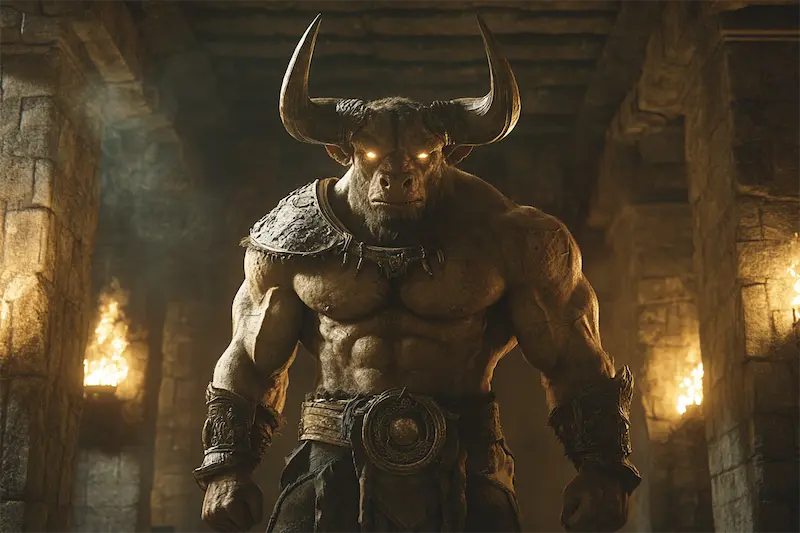What Is the Minotaur?
The Minotaur is one of the most iconic mythical creatures in ancient Greek mythology. With the muscular body of a man and the fierce head of a bull, the Minotaur symbolizes wildness, violence, and the mysterious depths of the human subconscious. It is more than just a monster—it represents tragedy, punishment, and courage in Greek culture.
According to legend, the Minotaur was born from an unnatural union between Queen Pasiphae of Crete and a divine bull sent by Poseidon. Its tragic and horrifying origin reflects the religious beliefs and moral lessons of the time.
Appearance and Characteristics
The Minotaur is often described as a towering, muscular creature. Its body resembles that of a powerful warrior, but instead of a human head, it has the head of a raging bull—with long horns and blazing eyes. This bizarre combination highlights its savage, uncontrollable nature.
The creature is usually depicted wearing only a rough piece of hide, emphasizing its primal instincts. Its roar is said to be deafening, like a maddened bull, terrifying anyone who hears it.
Origins and Symbolic Meaning
The Minotaur’s story begins with a broken promise. King Minos of Crete refused to sacrifice a white bull gifted by Poseidon. In revenge, the god cursed Queen Pasiphae to fall in love with the bull, resulting in the birth of the Minotaur.
This myth represents the consequences of defying the gods, the dangers of uncontrolled desires, and the hidden darkness within human nature. The Minotaur symbolizes primal instincts, inner conflict, and the chaos that arises when logic and morality are ignored.
Physical Strength and Abilities
The Minotaur is incredibly strong—likened to an unbeatable gladiator. It could lift enemies and smash through obstacles with ease. Its bull’s head was not just for intimidation; it became a deadly weapon when the beast charged at its victims like a wild bull.
Despite its strength, the Minotaur lacked intelligence. It acted mainly on instinct, living in the Labyrinth—a massive maze built by the architect Daedalus on the orders of King Minos. The creature survived by devouring the humans sent into the Labyrinth each year as sacrifices.
Famous Myths: Theseus and the Minotaur
The most famous tale involving the Minotaur is that of Theseus, the hero of Athens and son of King Aegeus. Each year, Athens had to send seven boys and seven girls to Crete as tribute to be fed to the Minotaur. Theseus volunteered to join them, aiming to end the bloodshed.
With the help of Princess Ariadne—King Minos’s daughter—Theseus was given a ball of thread to trace his path through the Labyrinth. He successfully found and killed the Minotaur after a fierce battle, then used the thread to escape. This heroic act made him a legend in Greek mythology.
Influence in Modern Culture
The Minotaur continues to inspire modern art, literature, film, and video games. In books, it often symbolizes hidden fears or the wild, uncontrollable side of human nature.
In films like Immortals and the Percy Jackson series, the Minotaur appears as a deadly adversary. In games like God of War and Assassin’s Creed Odyssey, it serves as a powerful final boss that tests players’ strength and courage.
In modern art—from sculpture to painting—the Minotaur often represents tragedy and the raw essence of human instincts.
Similar or Opposing Mythical Creatures
The Minotaur is often contrasted with the Centaur—another half-human creature. While Centaurs represent the balance between instinct and wisdom, the Minotaur is driven purely by violence and base desires.
Another related creature is the Sphinx. Both guard labyrinths and challenge those who approach. However, the Sphinx uses riddles and intellect, while the Minotaur relies on brute force.
The Minotaur in Feng Shui and Symbolism
Although not commonly found in Eastern Feng Shui, the Minotaur occasionally appears in Western decor. It symbolizes power, determination, and the strength to overcome adversity.
However, due to its fearsome image and tragic origin, the Minotaur is rarely used in living spaces—unless for artistic or symbolic purposes, often to convey deep philosophical messages.
Conclusion
The Minotaur is more than a terrifying creature from ancient Greek mythology—it is a powerful symbol of internal struggle, instinct, and the consequences of human defiance. Its story is one of tragedy, bravery, and the journey to conquer inner darkness.
For centuries, the image of the Minotaur has remained deeply embedded in human culture. It continues to captivate and inspire, proving that the legends of old still resonate with the fears, strengths, and hopes of modern society.
